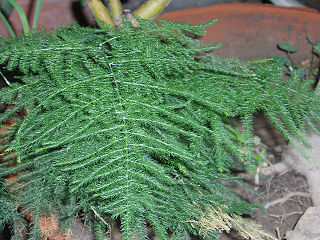
Asparagus is a genus of flowering plants in the family Asparagaceae, subfamily Asparagoideae. It comprises up to 300 species. Most are evergreen long-lived perennial plants growing from the understory as lianas, bushes or climbing plants. The best-known species is the edible Asparagus officinalis, commonly referred to as just asparagus. Some other members of the genus, such as Asparagus densiflorus, are grown as ornamental plants.

Asparagus racemosus is a species of asparagus native from Africa through southern Asia, including the Indian subcontinent, to northern Australia. It grows 1–2 m tall and prefers to take root in gravelly, rocky soils high up in piedmont plains, at 1,300–1,400 m (4,300–4,600 ft) elevation. It was botanically described in 1799. Because of its multiple uses, the demand for Asparagus racemosus is constantly on the rise. Due to destructive harvesting, combined with habitat destruction, and deforestation, the plant is now considered "endangered" in its natural habitat.

Tragus, commonly called bur gras, burr grass or carrot-seed grass, is a genus of plants in the grass family. It is native to Africa, Australia, and Eurasia with several species on islands in the Atlantic, Indian, and Pacific Oceans plus one species in Argentina.

Mucor racemosus is a rapidly growing, weedy mould belonging to the division Mucoromycota. It is one of the earliest fungi to be grown in pure culture and was first isolated in 1886. It has a worldwide distribution and colonizes many habitats such as vegetational products, soil and houses. The fungus is mostly known for its ability to exhibit both filamentous and yeast-like morphologies, often referred to as dimorphism. Stark differences are seen in both forms and conditions of the environment heavily affect the phases of the M. racemosus. Like many fungi, it also reproduces both sexually and asexually. The dimorphic capacity of this species has been proposed as an important factor in its pathogenicity and has enhanced the industrial importance. This species is considered an opportunistic pathogen, generally limited to immunocompromised individuals. It also been associated with allergy and inflammations of facial sinuses. Its association with allergy has made it a common fungus used in allergen medical testing. Industrial use of the fungus is in the production of enzymes and the manufacture of certain dairy foods.

Thereianthus is a genus of flowering plants in the family Iridaceae, first described as a genus in 1941. The entire genus is endemic to Cape Province in South Africa.
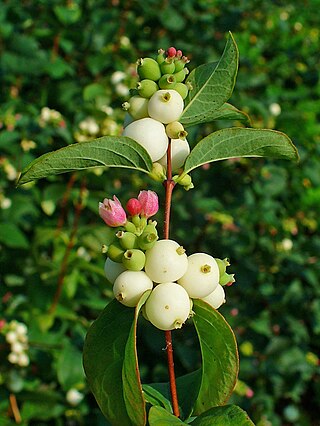
Symphoricarpos albus is a species of flowering plant in the honeysuckle family known by the common name common snowberry. Native to North America, it is browsed by some animals and planted for ornamental and ecological purposes, but is poisonous to humans.
Endostemon (keepsafe) is a genus of plants in the family Lamiaceae, first described in 1910. It is native primarily to eastern Africa, with some species in central and southern Africa, the Arabian Peninsula, Madagascar, and the Indian subcontinent.
- Endostemon albusA.J.Paton, Harley & M.M.Harley - Kenya, Tanzania, Mozambique
- Endostemon camporum(Gürke) M.R.Ashby - Kenya, Tanzania
- Endostemon ctenoneurusHarley - Kenya, Somalia
- Endostemon glandulosusHarley & Sebsebe - Ethiopia
- Endostemon gracilis(Benth.) M.R.Ashby - Kenya, Somalia, Tanzania, Yemen
- Endostemon kelleri(Briq.) Ryding ex A.J.Paton & Harley - Kenya, Somalia, Ethiopia
- Endostemon leucosphaerus(Briq.) A.J.Paton, Harley & M.M.Harley - Somalia, Ethiopia
- Endostemon membranaceus(Benth.) Ayob. ex A.J.Paton & Harley - Cameroon, Angola, Central African Republic
- Endostemon obbiadensis(Chiov.) M.R.Ashby - Somalia
- Endostemon obtusifolius(E.Mey.) N.E.Br. - from South Africa north to Angola and Tanzania
- Endostemon racemosusRyding, A.J.Paton & Thulin - Somalia
- Endostemon stenocaulis(Hedge) Ryding, A.J.Paton & Thulin - Somalia
- Endostemon tenuiflorus(Benth.) M.R.Ashby - eastern + southern Africa, Madagascar, Arabian Peninsula
- Endostemon tereticaulis(Poir.) M.R.Ashby - widespread across much of tropical Africa, also Yemen + Saudi Arabia
- Endostemon tomentosusHarley & Sebsebe - Somalia
- Endostemon tubulascens(Briq.) M.R.Ashby - Angola
- Endostemon usambarensisM.R.Ashby - Tanzania
- Endostemon villosus(Briq.) M.R.Ashby - central Africa
- Endostemon viscosus(Roth) M.R.Ashby - India, Assam, Sri Lanka
- Endostemon wakefieldii(Baker) M.R.Ashby - Kenya

The Shatavar Vatika Herbal Park, Hisar, named after the shatavar herb, is a 125-acre herbal park for the conservation of several endangered ayurvedic medicinal herbs. It is located on Hisar-Dhansu road, which runs off 'Hisar-Barwala NH-52', in Hisar city of Haryana state in India.
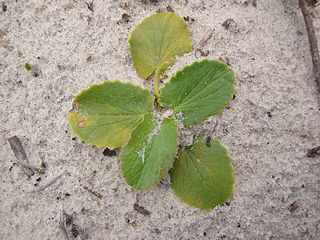
Ch. Surender Singh Memorial Herbal Park, Tosham is a herbal and medicinal plants park in Tosham town of Bhiwani district in the Indian state of Haryana.
Sarocalamus is a genus of Asian bamboo in the grass family.
- Sarocalamus faberi(Rendle) Stapleton – Sichuan, Yunnan, Guizhou
- Sarocalamus racemosus(Munro) Stapleton – Tibet, Assam, Arunachal Pradesh, Myanmar, Bhutan, Sikkim, Nepal
- Sarocalamus spanostachyus(T.P.Yi) Stapleton – Sichuan

Tragus racemosus, commonly referred to as stalked bur grass, European bur grass, or large carrot seed grass, is a species of grass native to Europe. It is often confused with a similar plant of the same genus, Tragus berteronianus. It is a monocot and is considered a weed in many countries and is a relatively uncommon seed contaminant.

Symphyotrichum racemosum is a species of flowering plant native to parts of the United States and introduced in Canada. It is known as smooth white oldfield aster and small white aster. It is a perennial, herbaceous plant in the family Asteraceae. It is a late-summer and fall blooming flower.
Echinocystis macrocarpa can refer to:

Echinopepon is a genus of flowering plants in the family Cucurbitaceae, native to the southwestern United States, Mexico, Central America, and South America. Tendrillate vines, their prickly fruits are operculate, with the prickles themselves being stipitate glandular.
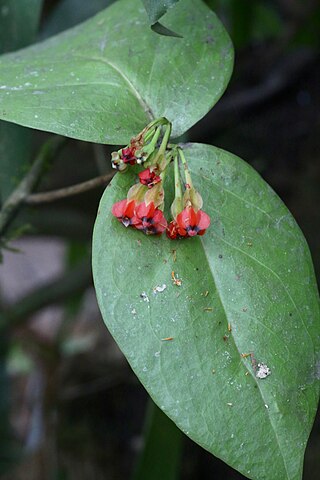
Anthopterus is a genus of flowering plants belonging to the family Ericaceae.
Calycobolus is a genus of flowering plants belonging to the family Convolvulaceae.
Decalepidanthus is a genus of flowering plants belonging to the family Boraginaceae.
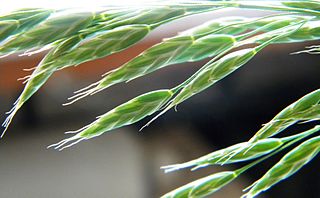
Bromus racemosus, the smooth brome or bald brome, is a species of flowering plant in the family Poaceae. It is native to subarctic and temperate Eurasia, and widely introduced elsewhere, including North America, Iceland, the Southern Cone of South America, the Korean Peninsula, Australia, and New Zealand. It grows in alkaline meadows and in waste places.
Astragalus racemosus, the cream milkvetch, is a species of flowering plant in the family Fabaceae. It is native to central North America. A selenium hyperaccumulator, it is considered capable of poisoning livestock as one of the locoweeds.
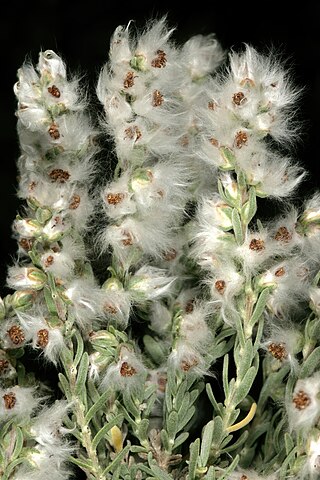
Eriocephalus racemosus is a species of flowering plant in the genus Eriocephalus. It is endemic to the Cape Provinces of South Africa. It is also called the kapokbos.













